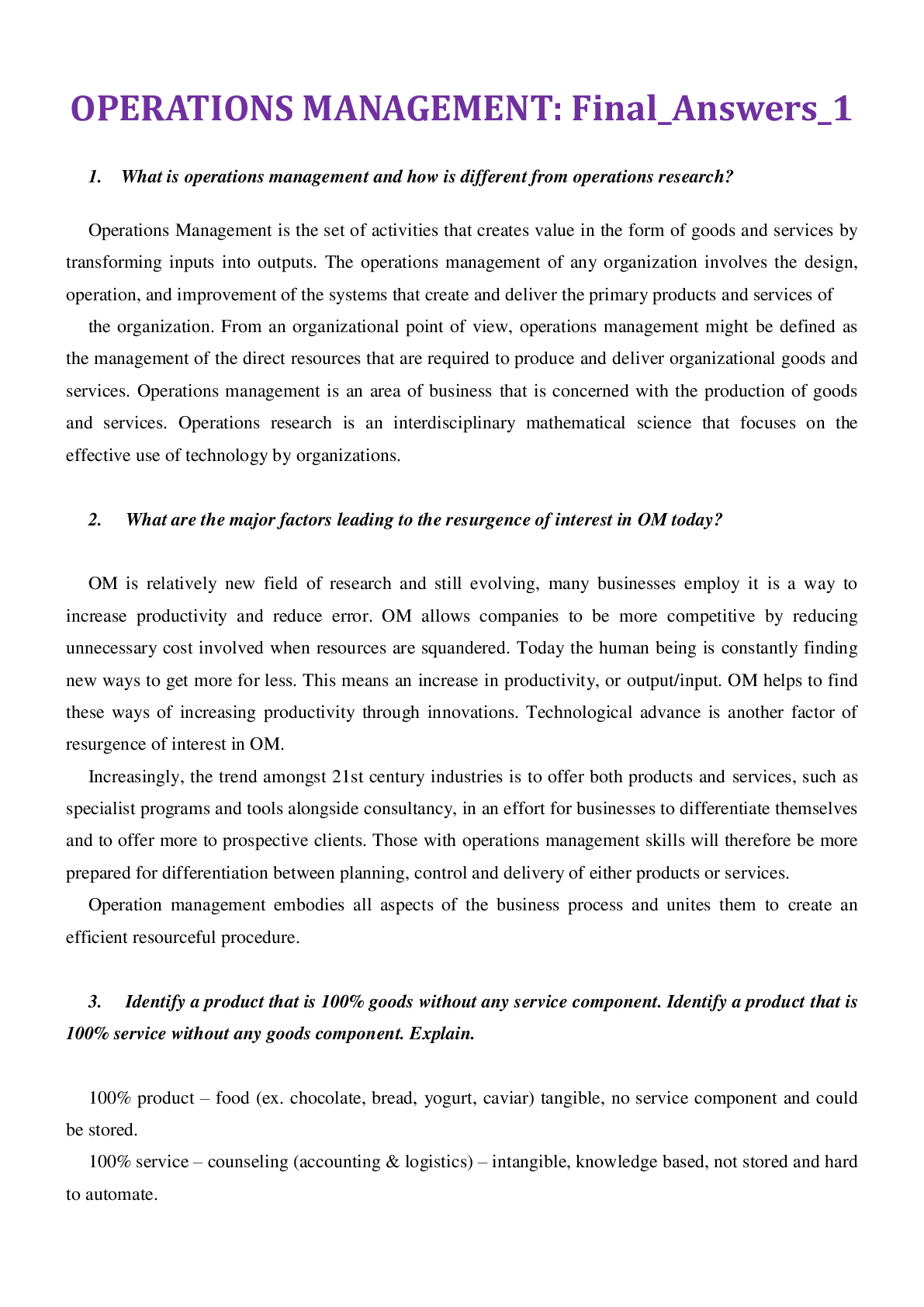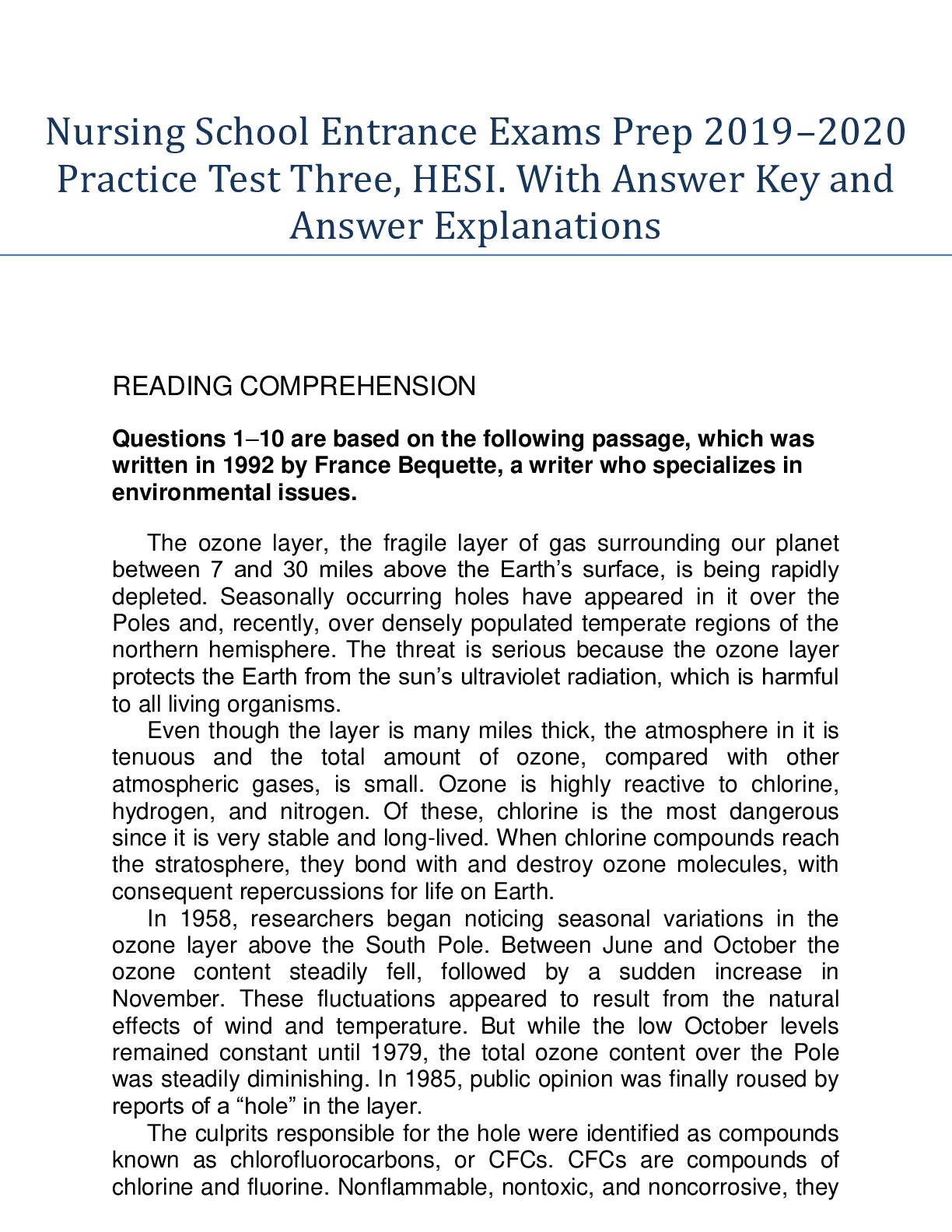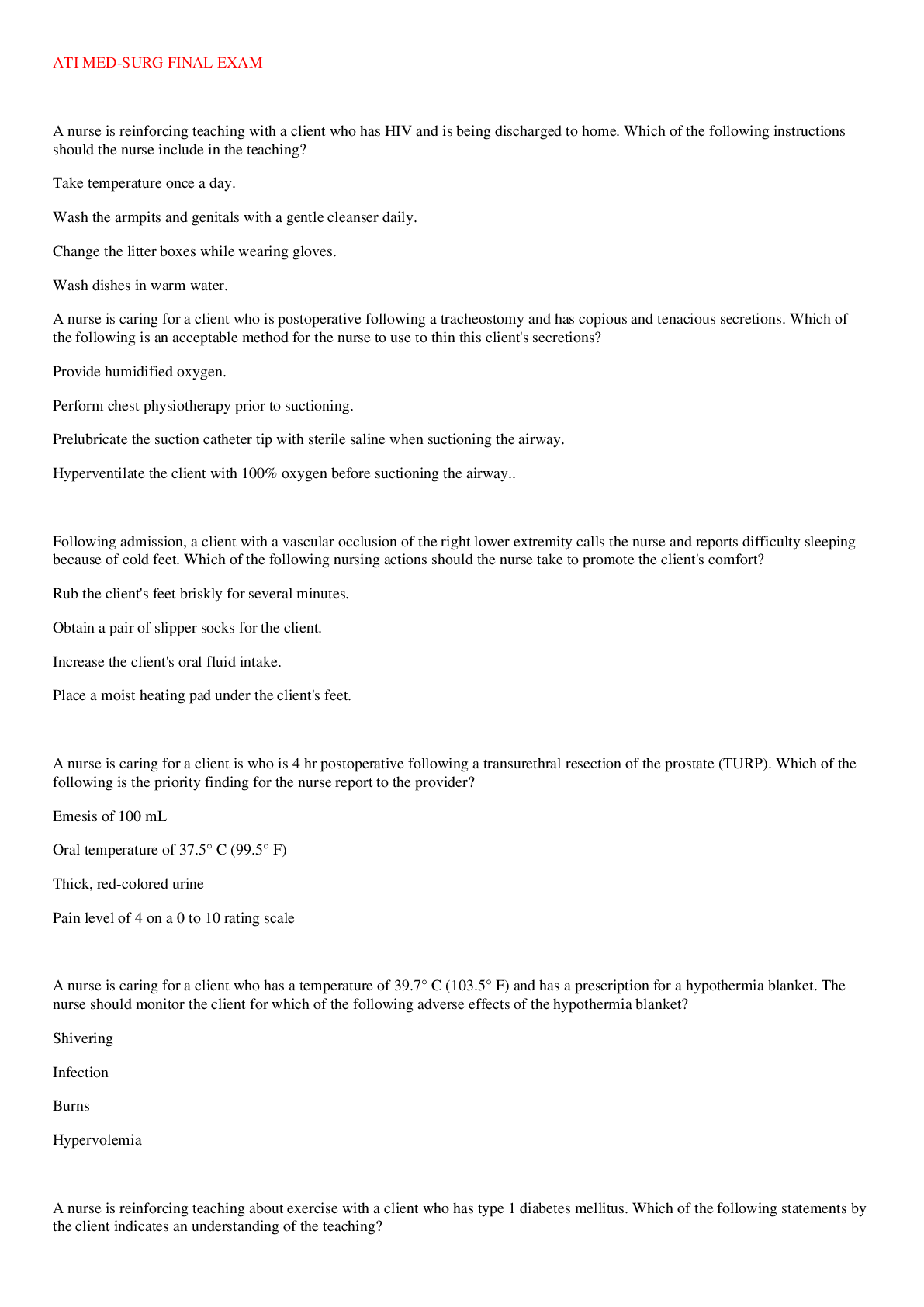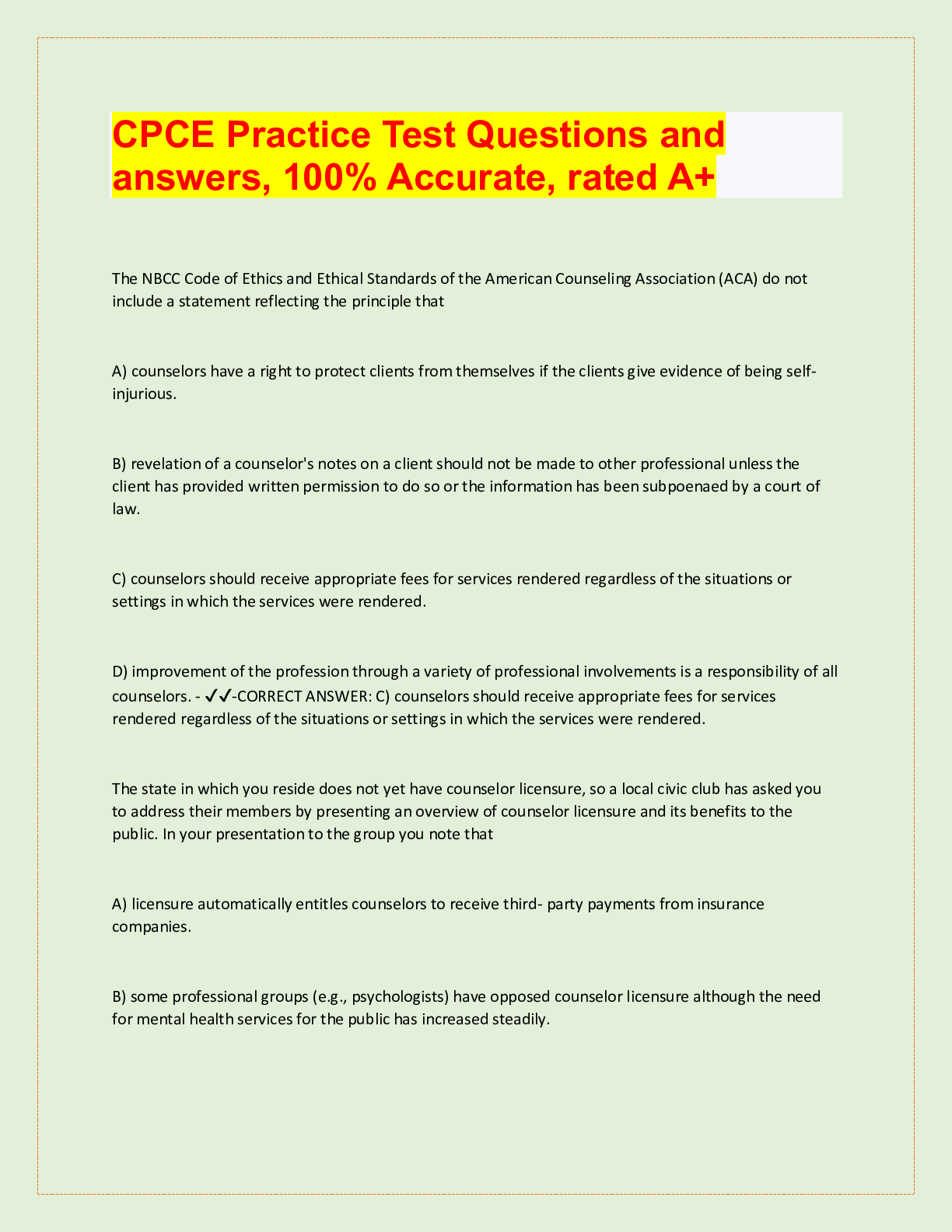Operations Management > QUESTIONS & ANSWERS > OPERATIONS MANAGEMENT: Final_Answers_1. This document contains 130 Questions and Answers. (All)
OPERATIONS MANAGEMENT: Final_Answers_1. This document contains 130 Questions and Answers.
Document Content and Description Below
OPERATIONS MANAGEMENT: Final_Answers_1 1. What is operations management and how is different from operations research? 2. What are the major factors leading to the resurgence of interest in OM ... today? 3. Identify a product that is 100% goods without any service component. Identify a product that is 100% service without any goods component. Explain. 4. Mass customization and rapid product development were identified as current trends in modern manufacturing operations. What is the relationship, if any, between these trends? Can you cite any examples? 5. How does an OM strategy change during a product’s life cycle? 2.2 Birth (or Introduction stage) 2.3 Growth stage 2.4 Maturity stage 2.5 Death stage. 3. Life-cycle costing 4. Conclusion . 6. How must an operations strategy integrate with marketing and accounting? 7. What is meant by competitiveness? 8. For each of the different competitive priorities, describe the unique characteristics of the market niche with which it is most compatible. 9. Describe the difference between order-qualifiers and order-winners. What is the relationship between the two over time? 10. In your opinion, does business school have competitive priorities? 11. What kind of information do you think would add value to the following goods and services? a) used car b) hotel in a foreign city c) cruise ship d) college 12. Describe the type of service that would make the following items more attractive to purchase. a) suit of clothes b) used car c) personal computer d) fruits and vegetables 13. Define project management. 14. Describe and define work breakdown structure, program, project, task, subtask, and work package. 15. How does the role of a project manager differ from that of a traditional functional manager? 16. What are some of the key characteristics of high-performance work teams? 17. What are some of the reasons project scheduling is not done well? 18. Which characteristics must a project have for critical path scheduling to be applicable? What types of projects have been subjected to critical path analysis? 19. What are the underlying assumptions of minimum-cost scheduling? Are they equally realistic? 20. “Project control should always focus on the critical path”. Comment. 21. Why would subcontractors for a government project want their activities on the critical path? Under what conditions would they try to avoid being on the critical path? 22. What is meant by "Crashing a project," and when do you do this? 23. Students are sometimes confused by the concept of critical path, and want to believe that it is the shortest path through a network. Convincingly explain why this is not so. 24. How can we determine the probability that a project will be completed by a certain date? What assumptions are made in this computation? 25. Describe the meaning of slack, and discuss how it can be determined. 26. Why it is important for a firm to have an effective new product (or service) development process? 27. What are the benefits to the firm that can develop new products faster than its competition? 28. Describe the three categories of new products. Discuss how each category differs from the others in terms of resources expended and the effect on the firm’s manufacturing processes. 29. Discuss the four types of new service. 30. What is the difference between incremental and radical service innovations? 31. Describe what is meant by the “voice of customer”. 32. Identify and describe the four major phases of the new product development. 33. Identify and describe the four stages of the new service developmet (NSD) process. 34. Why is it important for managers to understand the relationship between the stages of a product’s life cycle and the types of processes that are available to manufacture that product? 35. a) List specific products that you especially like. What do you like most about them? b) Create a list of products that you dislike or are unhappy with. What don’t you like about them? c) Are there some common reasons for your lists? For example, is it more important for products that you don’t see or see very little to be functional rather than attractive (e.g., the furnace or air conditioning in the house, the transmission or engine in the car)? Is it more important for things to be well designed that other people see and relate to you such as your car, your clothes, or your appartment of home furnishings? Can you formulate some general design guidelines based on your answer? 36. Pick a product and make a list of issues that need to consider in its design and manufacture. The product can be something such as a stereo, a telephone, a desk, a kitchen appliance, and so on. Consider the functional and aesthetic aspects of design as well as the important concerns for manufacturing. 37. The first step in studying a production process is to develop a description of that process. Once the process is described, we are better to determine why it works well or poorly and to recommend production-related improvements. Since we are all familiar with fast-food restaurants, try your hand at describing the production process employed at, say, a McDonald’s. In doing so, answer the following questions: a. What are the important aspects of the service package? b. Which skills and attitudes are needed by the service personnel? 38. Is quality free? Debate. 39. Identify the quality dimensions for each of the following: a) Personal computer b) Steakhouse c) University d) Television 40. An agreement is made between a supplier and a customer such that the supplier must ensure that all parts are within tolerance before shipment to the customer. What is the effect on the cost of quality to the customer? 41. If line employees are required to assume the quality control function, their productivity will decrease. Discuss this. 42. “You don’t inspect quality into a product; you have to build it in.” Discuss the implications of this statement. 43. How is the Baldrige Award process beneficial to companies who do not win? 44. What are the some contributions of the ISO 9000 standards/certification to the international business? 45. Compare the ISO certification process with the Malcolm Baldrige National Quality Award criteria. What are the main differences? 46. What are some of the reasons that quality initiatives fail in organizations? How can these be overcome? 47. What are some of the major reasons for the success of Six Sigma? 48. Explain, in your own words, the meaning of the correlation coefficient. Discuss the meaning of a negative value of the correlation coefficient. 49. Develop a histogram of the time it took for you or your friends to receive six recent orders at a fast-food restaurant. 50. Give examples of industries that are affected by seasonality. Why would these businesses want to filter out seasonality? 51. Consider the everyday task of getting to work on time or arriving at your first class on time in the morning. Draw a fish-bone chart showing reasons why you might arrive late in the morning. 52. Discuss the trade-off between achieving a zero AQL (acceptable quality level) and a positive AQL (e.g., an AQL of 2%). 53. The capability index allows for some drifting of the process mean. Discuss what this means in terms of product quality output. 54. Discuss the purposes and differences between p-charts and X and R charts. 55. Discuss the logic of Taguchi methods. 56. What is the difference between a Type I error and a Type II error? 57. What is the difference between a Pareto chart and a histogram? 58. Explain how a person using 2-sigma control charts will more easily find samples “out of bounds” than 3-sigma charts. What are some possible consequences of this fact? 59. Can a production process be labeled as “out of control” because it is too good? Explain. 60. Define Cpk and explain what a Cpk of 1 means. What is Cp? 61. Discuss the managerial issues regarding the use of control charts. 62. What type of process is used for making each of the following products? a) Beer b) Wedding invitations c) Automobiles d) Paper e) “Big Macs” f) Custom homes g) Motorcycles h) What is service blueprinting? 63. What are the techniques for improving service productivity? 64. Describe briefly what an automatic identification system (AIS) is and how service organizations could use AIS to increase productivity and at the same time increase the variety of services offered. 65. In what ways can a technology affect an operation? Use examples in both manufacturing and service operations. 66. What are the benefits of automation in a manufacturing company? 67. Distinguish between design capacity and effective capacity. 68. What are the assumptions of break-even analysis? 69. Under what conditions would a firm want its capacity to lag demand? To lead demand? 70. What is effective capacity? What is efficiency? 71. Elmer’s Fudge Factory is planning to open 10 retail outlets in Oregon over the next 2 years. Identify (and weight) those factors relevant to the decision. Provide this list of factors and weights. 72. What is random stocking? 73. Although most organizations may make the location decision infrequently,, there are some organizations that make the decision quite regularly and often. Provide one or two examples. How might their approach to the location decision differ from the norm? 74. What are the variables that a manager can manipulate in a retail layout? 75. Why do so many successful companies build facilities in other countries? 76. How does factor weighting incorporate personal preference in location choices? 77. What are the advantages and disadvantages of a qualitative (as opposed to a quantitative) approach to location decision making?379 page 78. Although most organizations may make the location decision infrequently, there are some organizations that make the decision quite regularly and often. Provide one or two examples. How might their approach to the location decision differ from the norm? 79. Explain the assumptions behind the center-of-gravity method. How can the model be used in a service facility location. 80. Why shouldn’t low wage rates alone be sufficient to select a location? 81. List the techniques used by service organizations to select locations. 82. Contrast the location of a food distributor and a supermarket. (The distributor sends truckloads of food, meat, produce, etc., to the supermarket). Show the relevant considerations (factors) they share; show those where they differ. 83. What are the three factors that complicate a fixed-position layout? 84. What are the advantages and disadvantages of process layout? 85. What are the advantages and disadvantages of product layout? 86. What are the advantages and disadvantages of work cells? 87. How do you classify the time for a machine operator who, between every job and sometimes in the middle of jobs, turns off the machine and goes for stock? 88. What are the differences among job enrichment, job enlargement, job rotation, job specialization, and employee empowerment? 89. What are some of the worst jobs you know about? Why are they bad jobs? Why do people want these jobs? 90. Can you think of any jobs that push the man-machine interface to the limits of human capabilities? 91. Define vertical job expansion and horizontal job expansion. Explain clearly how they differ. 92. Define ergonomics. Discuss the role of ergonomics in job design. 93. As a new time-study engineer in your plant, you are engaged in studying an employee operating 94. What is the difference between “normal” and “standard” times? 95. What kind of work-pace change might you expect from an employee during a time study? Why? 96. How would you classify the following job elements? Are they personal fatigue or delay? 97. How do you classify the time for a machine operator who, between every job and sometimes in the middle of jobs, turns off the machine and goes for stock? 98. Describe Gilbreth’s approach to setting work standards. 99. What are the advantages and disadvantages to a firm having a small number of suppliers? 100. Supply chain management pertains primarily to goods. What would be the different steps or elements in a supply chain for a service? Give an example. 101. How has technology impacted a firm’s supply chain and the trend toward disintermediation? 102. What are the main differences between having a vendor’s employees working in your manufacturing operation and you hiring your own employees to do the same work? 103. How do we distinguish between supply-chain management, purchasing, and logistics management? 104. What is vertical integration? Give examples of backward and forward integration. 105. How does a traditional adversarial relationship with suppliers change when a firm makes a decision to move to a few suppliers? 106. What are blanket orders? How do they differ from in voiceless purchasing? 107. What can purchasing do to implement JIT deliveries? 108. When quantity discounts are offered, why is it not necessary o check discount points that are below the EOQ or points above the EOQ that are not discount points? 109. When demand is not constant, the reorder point is a function of what four parameters? 110. Explain the significance of a negative improvement index in a transportation-minimizing problem. 111. Explain what is meant by the expression “robust model”. Specifically, what would you tell a manager who exclaimed, “Uh-oh, we’re in trouble! The calculated EOQ is wrong, actual demand is 10% greater than estimated.” 112.Explain the following: all things being equal, the production inventory quantity will be larger than the economic order quantity. 113. The more sources and destinations there are for a transportation problem, the smaller the percentage of all cells that will be used in the optimal solution. Explain. 114. Identify and explain the types of costs that are involved in an inventory system. 115. Explain why it is not necessary to include product cost (price or price times quantity) in the EOQ model, but the quantity discount model requires this information. 116. What are the advantages of cycle counting? 117. What is “safety stock”? What does safety stock provide safety against? 118. When demand is not constant, the reorder point is a function of what four parameters? 119. State a major advantage, and a major disadvantage, of a fixed-period system. 120. What is a qualitative forecasting model, and when is it appropriate? Qualitative forecasts incorporate such factors as the decision maker’s intuition, emotions, personal experiences and value system 121. Identify and briefly describe the two general forecasting approaches. 122. Identify the three forecasting time horizons. State an approximate duration for each. 123. Explain why such forecasting devices as moving averages, weighted moving averages, and exponential smoothing are not well suited for data series that have trends. 124. What is the basic difference between a weighted moving average and exponential smoothing? 125. What three methods are used to determine the accuracy of any given forecasting method? How would you determine whether time-series regression or exponential smoothing is better in a specific application? Mean absolute deviation (MAD) – Mean squared error (MSE) – Mean absolute percent error (MAPE) – 126. A skeptical manager asks what medium-range forecasts can be used for. Give the manager three possible uses/purposes. 127. Give examples of industries that are affected by seasonality. Why would these businesses want to filter out seasonality? 128. Give examples of industries in which demand forecasting is dependent on the demand for other products. 129. What happens to the ability to forecast for periods further into the future? 130. What is the different between a dependent and an independent variable? [Show More]
Last updated: 1 year ago
Preview 1 out of 36 pages

Reviews( 0 )
Document information
Connected school, study & course
About the document
Uploaded On
Jan 21, 2021
Number of pages
36
Written in
Additional information
This document has been written for:
Uploaded
Jan 21, 2021
Downloads
0
Views
131




















.png)


.png)


.png)


.png)

.png)
.png)
.png)

